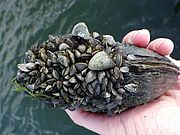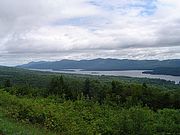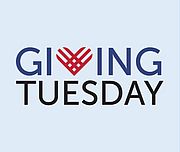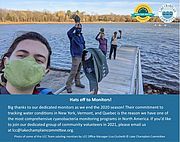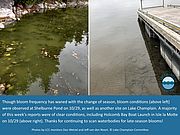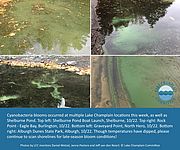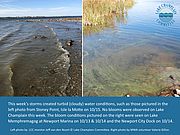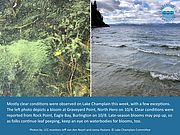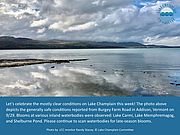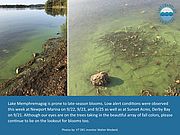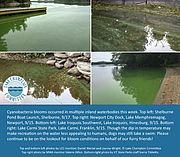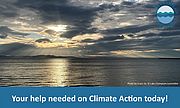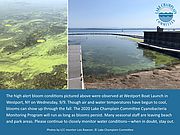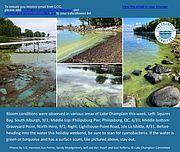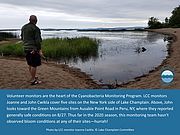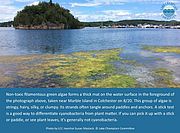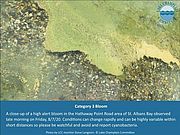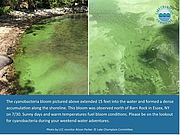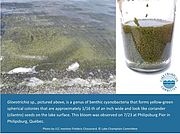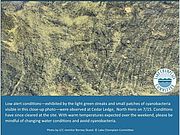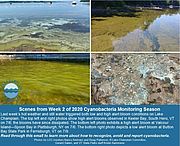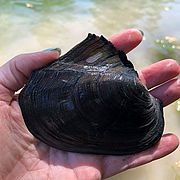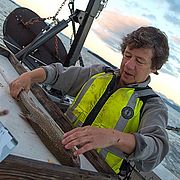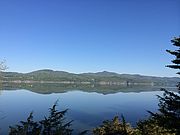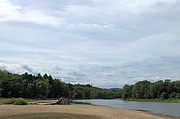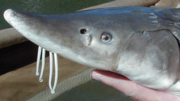The University of Vermont (UVM) plans to replace its aging research boat with a hybrid electric “model of seaworthy sustainability”. The quiet, low-emission vessel will be able to run on electric power for two hours and be used as a floating classroom and laboratory for lake education and science. Read...
News from Selected Month
First discovered in the southern part of Lake Champlain in 1993, zebra mussels are now found throughout the lake in shallow water areas. Juvenile and adult zebra mussels attach to any hard surface—including native freshwater mussels, the lake’s most imperiled taxa. The Lake Champlain Committee is working with Michael Lew-Smith of Arrowwood Environmental to document the impacts of the invasive zebra mussels on native mussel populations as a first step in the conservation strategy. Learn more about zebra mussel impacts from Michael and fellow biologist Mark Ferguson (Vermont Fish & Wildlife Department) in this Outdoor Radio episode on Vermont Public Radio (VPR). Read...
Both Lake George and Mirror Lake in New York experienced cyanobacteria blooms in early November 2020, the first time cyanobacteria was documented in either waterbody. The Lake George bloom was discovered by the Lake George Association, one of several nonprofits working to protect the lake’s water quality. Read...
Today is #GivingTuesday, the international day of giving, and a great day to support organizations that make a difference in your life. During this past year, we have all been reminded of the solace and beauty of nature and the importance of clean water. A donation today will strengthen LCC's advocacy, field work, and outreach to protect water quality and access. Thank you for your consideration! Read...
The 2020 Cyanobacteria Monitoring Season is a wrap! A huge thank you to our dedicated volunteers—in sun and rain, heat and cold, monitors collectively filed over 2,500 reports during this year’s 19-week season!
The Lake Champlain Committee’s work for clean, accessible water continues year-round. Please stay involved as the weather cools. Your testimony at hearings, letters to policy makers, and discussions with family and friends can have a meaningful impact on the health of our waterways. If you’d like to help us expand monitoring coverage on Lake Champlain or an inland waterbody next year, or are interested in taking a training for educational purposes, please sign up here: bit.ly/31WY7LnRead...
Most monitors who were still able to report observed good conditions this week—exceptions were low alert blooms at Eagle Bay, Rock Point in Burlington and on Shelburne Pond.
Next week will be the last week of formal reporting for the 2020 cyanobacteria monitoring season. If you’d like to help us expand monitoring coverage on Lake Champlain or an inland waterway next year, or are interested in taking a training for educational purposes, please sign up here: bit.ly/31WY7Ln. We’d love to have you! Read...
Lake Champlain’s Inland Sea, Main Lake North and Main Lake Central along with Shelburne Pond all experienced some blooms this week, while Lake Memphremagog’s previous blooms cleared out. Unseasonably warm temperatures may trigger additional cyanobacteria activity, so continue to check the water carefully, especially if you’re out with pets. Read...
No blooms were reported on Lake Champlain this week but Lake Memphremagog experienced low alert conditions.
Scroll through this report for a “flashback Friday” to the 2019 season, photos from this week’s reports, and a special notice for waterfowl hunters. Read...
Good conditions dominated the cyanobacteria tracker this week for both Lake Champlain and inland lake sites, but we have fewer monitors reporting during the shoulder season. Reports from Missisquoi Bay, Main Lake North, Malletts Bay, Main Lake Central, Main Lake South and South Lake all noted generally safe conditions. Low alerts were reported at some Inland Sea and St. Albans Bay locations.
While blooms are less frequent as temperatures cool, they can still happen. Last year, bloom reports continued into November. Saturday’s warm weather may trigger some cyanobacteria activity. Please continue to check the water carefully. Read...
Good conditions prevailed on most of Lake Champlain this week. A few notes of caution however: high alert blooms continue to persist at Lake Carmi and low alert blooms were observed on Lake Champlain’s Inland Sea and the South Lake as well as Lake Memphremagog and Shelburne Pond. When you’re checking out the foliage on the hillsides be sure to check the water for color too as blooms can still appear late in the season. Read...
Good conditions were observed this week in Missisquoi Bay, Main Lake Central, Main Lake South, and the South Lake on Lake Champlain and on several inland lakes where monitors are still able to report. Low level alerts were reported on the Inland Sea and Malletts Bay and Lake Iroquois and Lake Memphremagog. Hight alerts were witnessed on St. Albans Bay, Main Lake North, Halls Lake, Lake Carmi and Shelburne Pond. The sunny warm weather anticipated this week may trigger more blooms. Read...
We are more than halfway through the 2020 monitoring season. Report numbers will be lower as beaches and parks close up and seasonal staff leave their posts. However, it’s still a great time to recreate in and around waterways provided you’re well prepared for conditions. Please remember that cyanobacteria can still show up despite the cooling temperatures. Keep an eye on conditions whenever you are near the water and be especially mindful if you’re walking or wading shoreline areas with pets. Read...
On Tuesday evening, Governor Scott vetoed the Global Warming Solutions Act. The bill, which was overwhelmingly passed by both the Vermont House and Senate earlier, would require Vermont to reduce climate pollution and create a community-driven equitable plan to move off of fossil fuels towards energy independence. The measure will create jobs, improve community resilience, use natural systems and working lands to capture and store carbon, and create a deadline-driven process to hold the State accountable. A summary of the Solutions Act is below. Read...
There’s a nip of fall in the air and tinges of color on mountain slopes this week as some schools re-open, docks get pulled and state and municipal parks and beaches begin to close out their summer season. The change in temperature may decrease blooms in some areas and trigger them in others. Both inland waterways and Lake Champlain are subject to late summer and fall blooms so please continue to keep a watchful eye on the water and share information with others to raise awareness of cyanobacteria. Read...
While the cyanobacteria tracker map was dominated by green dots last week, too many red dots evidencing blooms are showing as we head into Labor Day weekend. While good conditions were observed at Lake Champlain’s Malletts Bay, Main Lake South, and South Lake and at numerous inland waterways, cyanobacteria blooms showed up in Missisquoi Bay, St. Albans Bay, the Inland Sea, Main Lake North and Main Lake Central on Lake Champlain as well as at Lake Carmi, Lake Morey and Shelburne Pond. Blooms can pop up or persist well into the fall so please continue to check conditions carefully whenever recreating near waterways. Read...
The cyanobacteria tracker was mainly populated by green dots this week indicating generally safe water conditions. However, blooms were observed in select locations both early and late in the week. Benthic cyanobacteria were also reported from a stream and private pond in Vermont. The cooler temperatures and rain ahead may lessen bloom frequency but cyanobacteria is still likely to show up in waterways for a while yet. Please keep a watchful eye and use the resources and tools in this email to help you learn how to identify, avoid and report cyanobacteria. Read...
Monitors filed 151 reports this week from Lake Champlain and inland lake sites. The cyanobacteria tracker map shows lots of green dots this week for generally safe conditions. However, blooms are still present in some areas of Lake Champlain and inland lakes. Read...
It’s been a tumultuous week with hot weather, intense rains that flushed nutrients and partially treated wastewater to Lake Champlain, and some high winds that knocked out power. In the midst of it all cyanobacteria monitors collectively filed 212 reports from Saturday August 8 through 1:30 p.m. on Friday August 14! Read...
The Lake Champlain Committee (LCC) and partners received 186 monitor reports last week from August 1 through 4:00 p.m. Friday August 7, 2020. Good conditions were observed in Lake Champlain’s Missisquoi Bay, Malletts Bay and the South Lake while blooms were reported for areas of St. Albans Bay, the Inland Sea, Main Lake North, Main Lake Central, and Main Lake South. Mixed conditions continued in Lake Carmi. Read...
The Lake Champlain Committee (LCC) and partners received 154 monitor reports this past week from Saturday July 25 through 1:45 p.m. Friday July 31. Good conditions were observed in Lake Champlain’s Missisquoi Bay, Main Lake North, Malletts Bay and the South Lake while blooms were reported for areas of St. Albans Bay, the Inland Sea, Main Lake Central, and Main Lake South. Mixed conditions continued in Lake Carmi this week and Lake Raponda also experienced a low alert. Read...
We received 183 monitoring reports last week through Lake Champlain Committee (LCC) Cyanobacteria Monitoring Program from Saturday July 18 through mid-afternoon Friday July 24. Due to the high volume of reports and some technical issues we weren’t able to send you the compilation until today. Read...
It’s been another busy week for the Lake Champlain Committee (LCC) Cyanobacteria Monitoring Program with 152 reports from Lake Champlain and inland lakes from Sunday July 12 through Friday July 17 at 1:30 pm! Good conditions were observed in Malletts Bay and Missisquoi Bay, there was one alert report in Main Lake Central and one in Main Lake North with mixed alert conditions in St. Albans Bay, the Inland Sea, and Main Lake South. Lake Carmi also had cyanobacteria alerts. Read...
Thank you for signing up to receive the Lake Champlain Committee’s (LCC) cyanobacteria monitoring reports! Monitoring will run through the early fall. Each week we’ll send you an update about conditions our monitors are finding around Lake Champlain and several inland lakes. This week’s report covers results from Sunday July 5 through late afternoon Saturday July 11. We had 159 reports that ranged from clear water conditions (perfect for cooling off in) to turquoise blooms that closed down access areas. Future reports will generally be sent to you on Fridays. Read...
If you’ve paddled, taken a swim, or cast a fishing line in the waterbodies of the Lake Champlain Basin, you’ve likely spent time among one of the most enigmatic groups of aquatic animals in our region: native freshwater mussels. They’re quirky—sporting hatchet-like shells and traveling by a single fleshy foot, yet familiar—related to the invasive zebra mussel and edible bivalves such as littleneck clams and scallops. Read...
Did you miss a “Zoom a Scientist” session? Don't worry! All the webinars are recorded and can be accessed via Youtube! Want to learn more about microplastics, climate change, or aquatic invasive species? Wonder how prepared we are for an oil spill or what fish do in winter? Curious about how scientists use drones and photogrammetry to learn about the lake? Read...
Vermont environmental advocates sent a letter to Governor Phil Scott on 4/6/20 thanking him for his efforts to address the unprecedented COVID-19 emergency, and urging him to uphold environmental and public health protections during the crisis, along with public accessibility and transparency.
Read...May is American Wetlands Month! Join us in celebrating our wetland wonders, from swamps and shores to floodplain forests and fens. Check out the LCC Facebook page where we’ve been posting about a different Lake Champlain watershed wetland every week. Read...
A sit spot is an outdoor site where you can go to slow down, soak up what’s around you, and appreciate nature. It is a location in your backyard or close to home—this is not a get-in-your-car activity—where you can observe changes in the natural world over time. With stay-close-to-home guidance in place, this activity can be a welcome refuge from the current uncertainty. Visit your sit spot on a timeline that works for you: daily, every other day, or weekly. We suggest returning to your sit spot at the same time of day, so you can intimately learn the patterns and rhythms of your site. Read...
Spring is a great time to recreate—blue skies, vegetation glowing green, woodland flowers bursting forth, birds in flight and song—all call us to get outside! With the recent easing of COVID-19 related restrictions on travel, we are all anxious to go further afield to exercise our bodies and lift our spirits outdoors. Please take precautions, Play Close to Home and remember that water is still deadly cold. Thank you for following these tips to help flatten the curve and keep people safe. We're in this together! Be well, everyone. Read...
Lake sturgeon can be unintentionally caught by anglers during May and June as they head upstream to spawn in the waters where they were born. The stress incurred from being hooked can inhibit their ability to reproduce. Lake sturgeon are a threatened species in New York and an endangered species in Vermont. There is no open season for lake sturgeon and possession is prohibited, so anglers should not be targeting these rare fish. Read...


